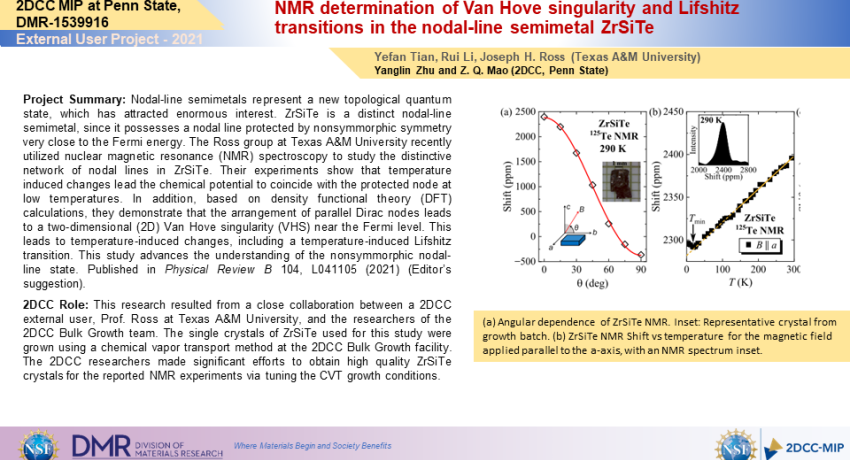Project Summary: Nodal-line semimetals represent a new topological quantum state, which has attracted enormous interest. ZrSiTe is a distinct nodal-line semimetal, since it possesses a nodal line protected by nonsymmorphic symmetry very close to the Fermi energy. The Ross group at Texas A&M University recently utilized nuclear magnetic resonance (NMR) spectroscopy to study the distinctive network of nodal lines in ZrSiTe. Their experiments show that temperature induced changes lead the chemical potential to coincide with the protected node at low temperatures. In addition, based on density functional theory (DFT) calculations, they demonstrate that the arrangement of parallel Dirac nodes leads to a two-dimensional (2D) Van Hove singularity (VHS) near the Fermi level. This leads to temperature-induced changes, including a temperature-induced Lifshitz transition. This study advances the understanding of the nonsymmorphic nodal-line state. Published in Physical Review B 104, L041105 (2021) (Editor’s suggestion).
2DCC Role: This research resulted from a close collaboration between a 2DCC external user, Prof. Ross at Texas A&M University, and the researchers of the 2DCC Bulk Growth team. The single crystals of ZrSiTe used for this study were grown using a chemical vapor transport method at the 2DCC Bulk Growth facility. The 2DCC researchers made significant efforts to obtain high quality ZrSiTe crystals for the reported NMR experiments via tuning the CVT growth conditions.
What Has Been Achieved: Demonstrate the Van Hove singularity and Lifshitz transition in the nodal-line semimetal ZrSiTe.
Importance of the Achievement: The nodal-line semimetal state protected by nonsymmorphic symmetry in ZrSiTe is a novel topological quantum state, which has attracted a great deal of interest. The demonstration of Van Hove singularity and Lifshitz transition via the NMR measurements shed light on the unique topological electronic structure of this material, which lays foundation for further understanding of nodal-line fermion physics.
Unique Feature(s) of the MIP that Enabled this Achievement: The 2DCC bulk growth team has not only expertise of crystal growth using various methods, but also strong background in material physics (The nodal-line semimetal state of ZrSiTe was first demonstrated by the 2DCC researchers in their previous work (2016 PRL)]. Such combination of material growth and material physics enables the 2DCC researchers to discover and grow novel quantum materials which can meet needs of various experiments and attract new users. This collaborative work directly benefits this unique feature of the 2DCC.
(If Applicable) Publication: Yefan Tian, Yanglin Zhu, Rui Li, Zhiqiang Mao, and Joseph H. Ross, Jr. Phys. Rev. B 104, L041105. Editor’s Suggestion. DOI:https://doi.org/10.1103/PhysRevB.104.L041105
This work was supported by the Robert A. Welch Foundation, Grant No. A-1526, and Texas A&M University. The
financial support for sample preparation was provided by the National Science Foundation through the Penn State 2D Crystal Consortium-Materials Innovation Platform (2DCC-MIP) under National Science Foundation Cooperative Agreement No. DMR-1539916.
